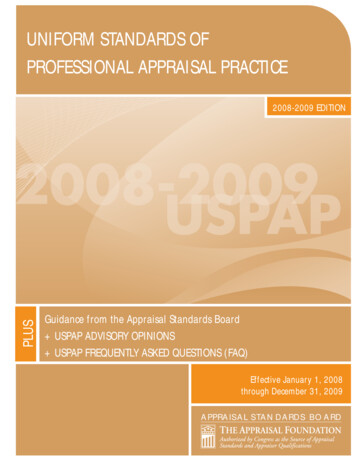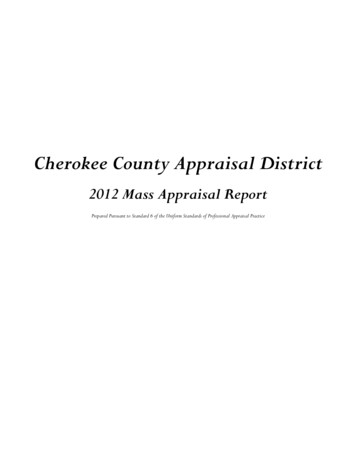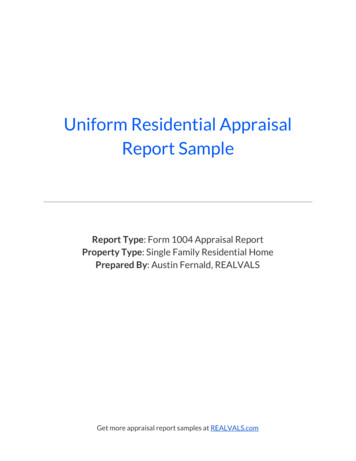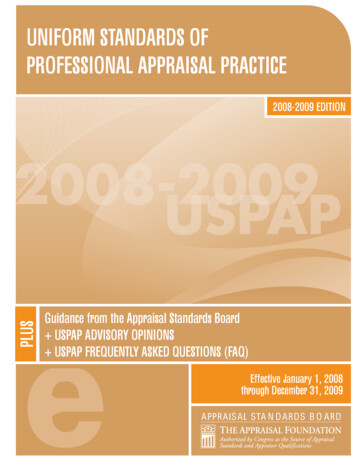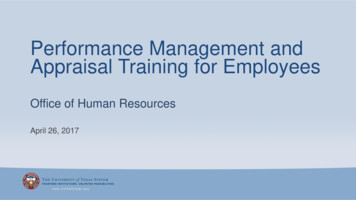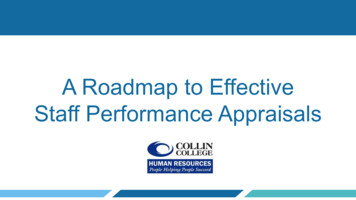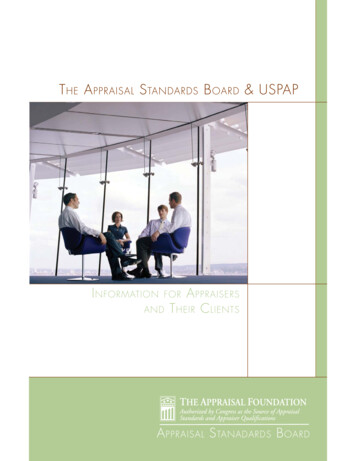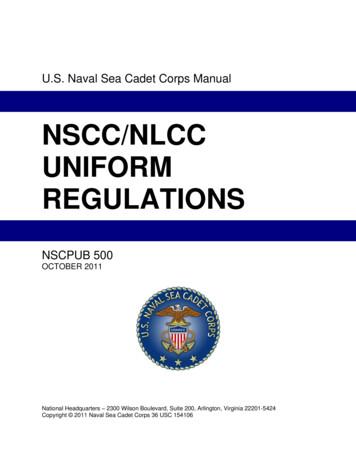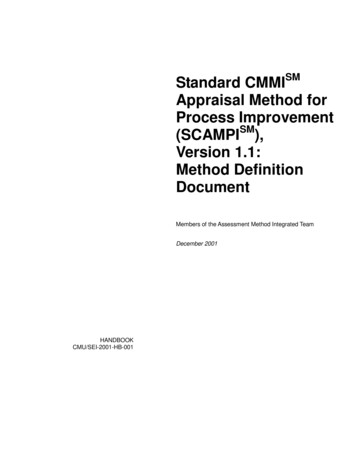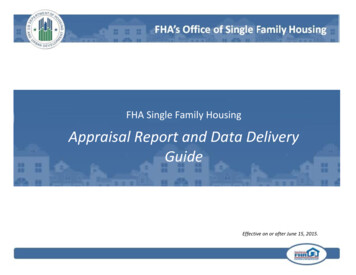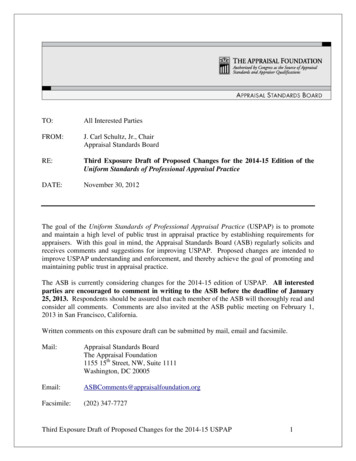
Transcription
TO:All Interested PartiesFROM:J. Carl Schultz, Jr., ChairAppraisal Standards BoardRE:Third Exposure Draft of Proposed Changes for the 2014-15 Edition of theUniform Standards of Professional Appraisal PracticeDATE:November 30, 2012The goal of the Uniform Standards of Professional Appraisal Practice (USPAP) is to promoteand maintain a high level of public trust in appraisal practice by establishing requirements forappraisers. With this goal in mind, the Appraisal Standards Board (ASB) regularly solicits andreceives comments and suggestions for improving USPAP. Proposed changes are intended toimprove USPAP understanding and enforcement, and thereby achieve the goal of promoting andmaintaining public trust in appraisal practice.The ASB is currently considering changes for the 2014-15 edition of USPAP. All interestedparties are encouraged to comment in writing to the ASB before the deadline of January25, 2013. Respondents should be assured that each member of the ASB will thoroughly read andconsider all comments. Comments are also invited at the ASB public meeting on February 1,2013 in San Francisco, California.Written comments on this exposure draft can be submitted by mail, email and facsimile.Mail:Appraisal Standards BoardThe Appraisal Foundation1155 15th Street, NW, Suite 1111Washington, DC imile:(202) 347-7727Third Exposure Draft of Proposed Changes for the 2014-15 USPAP1
IMPORTANT NOTE: All written comments will be posted for public viewing, exactly assubmitted, on the website of The Appraisal Foundation. Names may be redacted uponrequest.The Appraisal Foundation reserves the right not to post written comments that containoffensive or inappropriate statements.If you have any questions regarding the attached exposure draft, please contact Emily n,viae-mailatemily@appraisalfoundation.org or by calling (202) 624-3058.BackgroundThe Appraisal Standards Board promulgates USPAP for both appraisers and users of appraisalservices. The purpose of the Uniform Standards of Professional Appraisal Practice (USPAP) isto promote and maintain a high level of public trust in appraisal practice by establishingrequirements for appraisers. USPAP represents the generally accepted and recognized standardsof appraisal practice in the United States.The ASB’s work plan for the 2014-15 edition of USPAP includes reviewing and revising asneeded the following areas of USPAP: Reporting and Communication RequirementsReporting OptionsRetirement of STANDARDS 4 and 5Other revisions and additions as needed to ensure clarity and relevance.The Board currently intends to adopt any revisions for the 2014-15 edition of USPAP at itspublic meeting in San Francisco on February 1, 2013. Any such revisions would becomeeffective on January 1, 2014, and any updates related to USPAP course material should beavailable by late summer 2013.Third Exposure Draft of Proposed Changes for the 2014-15 USPAP2
Third Exposure Draft of Proposed Changes for the2014-15 Edition of the Uniform Standards of Professional Appraisal PracticeIssued: November 30, 2012Comment Deadline: January 25, 2013Each section of this exposure draft begins with a rationale for the proposed changes to USPAP.The rationale is identified as such and does not have line numbering. Where proposed changesto USPAP are noted, the exposure draft contains line numbers. This difference is intended todistinguish for the reader those parts that explain the changes to USPAP from the proposedchanges themselves.When commenting on various aspects of the exposure draft, it is very helpful to reference theline numbers, fully explain the reasons for concern or support, provide examples or illustrations,and suggest any alternatives or additional issues that the ASB should consider.Unless otherwise noted, where text is proposed to be deleted from USPAP, that text is shown asstrikeout. For example: This is strikeout text proposed for deletion. Text that is proposed to beadded to USPAP is underlined. For example: This is text proposed for insertion.For ease in identifying the various issues being addressed, the exposure draft is presented insections.NOTE: For the sake of clarity, in Sections 2 through 9, the proposed edits are shown based onthe assumption that STANDARDS 4 and 5 will be retired as presented in Section 1. If thatproposed change is not adopted, additional edits will be necessary.TABLE OF CONTENTSSection123456789IssueProposed Retirement of STANDARDS 4 and 5 (including revisions andadditional Illustrations proposed for Advisory Opinion 21)Proposed Revisions to the DEFINITIONS of “Assignment Results,”“Report,” and “Scope of Work”Proposed Revisions to the RECORD KEEPING RULEReport Options (includes proposal for options in STANDARDS 2, 8,and 10)Proposed Revisions to Advisory Opinion 11, Content of the AppraisalReport Options of Standards Rules 2-2 and 8-2 and Advisory Opinion12, Use of the Appraisal Report Options of Standards Rules 2-2 and 8-2Proposed Revisions to the COMPETENCY RULEProposed Revisions to the PREAMBLE - When Do USPAP Rules andStandards Apply?Proposed Revisions to Standards Rule 3-5Certification Requirement Related to Current or Prospective Interestand Prior ServicesThird Exposure Draft of Proposed Changes for the 2014-15 USPAPPage416192043535558603
Section 1:Proposed Retirement of STANDARDS 4 and 5 (including revisions andadditional Illustrations proposed for Advisory Opinion 21)RATIONALEOut of concern regarding the clarity, understandability, and enforceability of USPAP,respondents have offered a wide array of areas for examination, one of which includesSTANDARDS 4 and 5. These two Standards address Real Property Appraisal ConsultingDevelopment and Reporting. The purpose of an assignment under STANDARDS 4 and 5 is todevelop, without advocacy, an analysis, recommendation, or opinion where at least one opinionof value is a component of the analysis leading to the assignment results.As in the First and Second Exposure Drafts, the ASB continues to propose the retirement ofSTANDARDS 4 and 5 for the 2014-15 edition of USPAP.The ASB has requested comments for several years regarding the possible retirement ofSTANDARDS 4 and 5. In the past, there have been a few respondents that noted possibleunintended consequences if STANDARDS 4 and 5 were retired. These concerns have beenexamined and additional Illustrations are being proposed as discussed below to address thoseconcerns.The impact of retiring STANDARDS 4 and 5 would be that any additional opinions orrecommendations included within appraisal or appraisal review assignments will still be subjectto the ETHICS RULE, the COMPETENCY RULE, and the JURISDICTIONAL EXCEPTIONRULE. Effectively, most assignments that are currently appraisal consulting would becomeeither appraisal or appraisal review assignments with additional components. Those additionalcomponents remain a part of appraisal practice. This is consistent with the way in whichappraisal consulting in personal property and business appraisal assignments are currently treatedunder USPAP.With the proposed retirement of STANDARDS 4 and 5, the term and definition of “AppraisalConsulting” would be deleted and corresponding edits made throughout the USPAP publicationfor the 2014-15 edition. STANDARDS 6 through 10 will not be renumbered.To assist in demonstrating the impact of the retirement of STANDARDS 4 and 5, the proposededits to Advisory Opinion 21, USPAP Compliance, are shown in this exposure draft. These editsincluded the elimination of references to appraisal consulting and the addition of Illustrations 5a,5b, and 5c. In response to comments received regarding these illustrations, an additionalillustration (Illustration 5d) is being proposed in this Third Exposure Draft.Third Exposure Draft of Proposed Changes for the 2014-15 USPAP4
ADVISORY OPINION 21 (AO-21)1234This communication by the Appraisal Standards Board (ASB) does not establish new standardsor interpret existing standards. Advisory Opinions are issued to illustrate the applicability ofappraisal standards in specific situations and to offer advice from the ASB for the resolution ofappraisal issues and problems.5SUBJECT: USPAP Compliance6APPLICATION: Real Property, Personal Property, Intangible Property7THE ISSUE:89101112Individuals perform numerous roles within the broad realm of valuation services. Examplesinclude appraisal, brokerage, auctioning, property management, advocate consulting, appraisalreview consulting and collecting market data. Some valuation services are part of appraisalpractice and require compliance with USPAP. What are the USPAP compliance requirementsfor these various services? More specifically:13141516171819201.2.3.4.When should an individual comply with USPAP?What is the relationship between Valuation Services and Appraisal Practice?What does acting “as an appraiser” or performing a service “as an appraiser” mean?Why does an expectation for an individual to act as an appraiser indicate anobligation to comply with USPAP?5. What are the responsibilities of an appraiser regarding intended user expectations?6. What are the USPAP obligations for appraisal practice outside of appraisal, andappraisal review, and appraisal consulting?217. What are the USPAP obligations for valuation services outside of appraisal practice?22ADVICE FROM THE ASB ON THE ISSUE:231. When should an individual comply with USPAP?2425262728293031The PREAMBLE states that compliance with USPAP is required when either the service or theappraiser is obligated to comply by law or regulation, or by agreement with the client orintended users. An obligation to comply with USPAP is created by law, regulation, or agreementwith intended users.1 In such cases an appraiser must follow USPAP. The PREAMBLE alsostates that when not obligated, individuals may still choose to comply with USPAP. TheETHICS RULE states that an individual should comply any time that individual represents thathe or she is performing the service as an appraiser. 2 An ethical obligation to comply withUSPAP is created by choice, that is, by choosing to represent one’s self as an appraiser.1 USPAP gains legal authority through adoption by the various state and federal jurisdictions. Consequently, the legalrequirement to follow USPAP is rooted in federal and state laws or regulations.2 The PREAMBLE states that the appraiser’s responsibility is to protect the overall public trust and it is the importance of therole of the appraiser that places ethical obligations on those who serve in this capacity. However, the PREAMBLE alsostates that USPAP does not establish who or which assignments must comply. Neither The Appraisal Foundation nor itsAppraisal Standards Board is a government entity with the power to make, judge, or enforce law.Third Exposure Draft of Proposed Changes for the 2014-15 USPAP5
3233343536Therefore, When required by law, regulation, or agreement, an individual must comply withUSPAP.When choosing to represent oneself as an appraiser, an individual should comply withUSPAP.372. What is the relationship between Valuation Services and Appraisal Practice?383940A key to distinguishing an appraiser’s obligations is understanding the relationship between“valuation services” and “appraisal practice” in USPAP. Appraisal practice is a subset ofvaluation services.41424344“Valuation services” are services pertaining to aspects of property value. Appraisers and othersfor whom value is an issue provide valuation services. Examples include appraisal, brokerage,auctioning, property management, advocate consulting, appraisal review consulting andcollecting market data.45464748“Appraisal practice” is defined as valuation services performed by an individual acting as anappraiser. Only appraisers may offer services that are considered appraisal practice. Examplesinclude appraisal, appraisal consulting, appraisal review and collecting market data (acting as anappraiser).4950Since USPAP obligations apply to those who are acting as appraisers, USPAP applies toappraisal practice.513. What does acting “as an appraiser” or performing a service “as an appraiser” mean?525354555657An “appraiser” is defined as one who is expected to perform valuation services competently andin a manner that is independent, impartial, and objective (bold added for emphasis). Therefore,an individual “acting as an appraiser” is expected, in part, to be competent in the service beingprovided. Also, an individual “acting as an appraiser” is expected to provide the service in amanner that is independent, impartial, and objective. Performing a service in a manner that isindependent, impartial, and objective is an ethical requirement within USPAP.5859606162“Acting as an appraiser” means representing oneself as an appraiser. Many individuals haveother professional roles in addition to their appraiser role. For example, some appraisers are alsobrokers, consultants, or leasing agents. Individuals who have appraiser roles as well as otherprofessional roles must be careful to explain their role in performing a given valuation service(see question #7 below).6364656667Law, regulation, agreement, or representation (choice) each prescribes when a valuation serviceis to be provided by an appraiser as part of appraisal practice. Emphasizing another portion of thedefinition of an “appraiser” is one who is expected to perform valuation services competentlyand in a manner that is independent, impartial, and objective (bold added for emphasis). TheComment to the definition goes on to state that the expectation (for ethical and competentThird Exposure Draft of Proposed Changes for the 2014-15 USPAP6
6869performance) occurs when individuals, either by choice or by requirement represent that theycomply. Expectation is the crucial element in determining when one is acting as an appraiser.70714. Why does an expectation for an individual to act as an appraiser indicate an obligationto comply with USPAP?7273747576Public trust requires that when an individual is expected to perform with the ethics andcompetency of an appraiser, he or she will do so. An individual who agrees to perform avaluation service as an appraiser has a duty to comply with the ethics and competency that thepublic expects from an appraiser. This obligates the individual to comply with USPAP inperforming the service.7778The definition of an appraiser in conjunction with the need for public trust establishes the“expectation” as the basis for the obligation to comply with USPAP.7980818283848586Intended user expectations for valuation services performed in compliance with USPAP arecreated when an individual represents that he or she is acting as an appraiser in a service. Forexample, these expectations can arise when an individual advertises or solicits as an appraiser(such as telephone listings, professional directories, business cards, stationery, or office signage),holds appraiser accreditation from a licensing agency, or maintains membership in a professionalappraiser organization. An individual’s identification as an appraiser in a given valuation serviceestablishes a justifiable expectation that the valuation service will be performed in compliancewith USPAP.87888990In summary, expectation is the basis for determining when an individual providing a valuationservice is acting as an appraiser. Because of the need to preserve public trust and confidence inappraisal practice, the expectations of the client and other intended users for ethical andcompetent performance create an obligation to comply with USPAP.915. What are the responsibilities of an appraiser regarding intended user expectations?929394959697The appraiser has a professional responsibility to recognize the capacity in which he or she isperforming. The responsibility includes inquiry about, and recognition of, the intended users’expectations. When an individual’s appraisal expertise and reputation for providing serviceswithout bias induce the client or other intended users to select the individual to provide avaluation service, there is a justifiable expectation that the valuation service will be performed incompliance with USPAP.9899100101102103104105When an individual who acts as an appraiser in some circumstances chooses to provide avaluation service in some other capacity (i.e., not as an appraiser and outside of appraisalpractice), he or she must not represent himself or herself to be acting in the capacity of anappraiser. Since choice is an instrument to create USPAP obligations it follows that when anindividual has an opportunity to choose the capacity in which he or she will provide a valuationservice, he or she is free to provide the valuation service as an appraiser or in some othercapacity. However, an individual who is recognized as an appraiser must use great care not toviolate the public trust.Third Exposure Draft of Proposed Changes for the 2014-15 USPAP7
1061076. What are the USPAP compliance obligations for appraisal practice outside of appraisaland appraisal review, and appraisal consulting?108109110Within appraisal practice, there are some assignments that are addressed by the Standards (i.e.,STANDARDS 1 through 10). The Standards describe the requirements for appraisal, or appraisalreview, or appraisal consulting assignments.111112113114115116However, STANDARDS 1 through 10 do not apply in the performance of all appraisal practiceservices. Examples include assignments (performed as an appraiser) to teach appraisal courses,provide sales data, collect market data, analyze specific elements of value (e.g., reproduction costor functional utility), and develop educational texts. As defined in USPAP, assignments areperformed by an individual acting as an appraiser. Therefore, all assignments fall withinappraisal practice.117118119120121122Assignments to which STANDARDS 1 through 10 do not apply must still comply with theportions of USPAP that apply generally to appraisal practice. These include t TheDEFINITIONS, the PREAMBLE, the ETHICS RULE, the COMPETENCY RULE, and theJURISDICTIONAL EXCEPTION RULE apply generally to all appraisal practice. As a result,such assignments to which STANDARDS 1 through 10 do not apply must be provided withoutbias or accommodation of personal interest by competent appraisers.123124125126The RECORD KEEPING RULE applies to appraisal, and appraisal review, and appraisalconsulting assignments (i.e., STANDARDS 1 through 10). For other assignments, there are noworkfile or record keeping requirements in USPAP. The SCOPE OF WORK RULE also appliesonly to appraisal, and appraisal review, and appraisal consulting assignments.127128129130131132Some assignments may include appraisal or appraisal review as well as other analyses that leadto additional opinions or recommendations. In these assignments, the appraiser must complywith the USPAP requirements that apply to appraisal or appraisal review in the appraisal orappraisal review portion of the assignment and, at a minimum comply with the ETHICS RULE,the COMPETENCY RULE and the JURISDICTIONAL EXCEPTION RULE for the rest of theassignment.1337. What are the USPAP obligations for valuation services outside of appraisal practice?134135136137138139140141142143As previously stated, many individuals have other professional roles in addition to their appraiserrole. For example, some appraisers are also attorneys, accountants, brokers, or consultants.USPAP also places an obligation on an individual who sometimes acts as an appraiser evenwhen he or she provides a valuation service in some other capacity – that obligation being not tomislead the users of the valuation service about the capacity in which he or she is acting. TheETHICS RULE states that an appraiser must not misrepresent his or her role when providingvaluation services that are outside of appraisal practice. If a valuation service is premised onadvocacy or compensation arrangements that are contrary to the ETHICS RULE, the valuationservice is not consistent with the objectives of USPAP and cannot be performed by theindividual acting as an appraiser.Third Exposure Draft of Proposed Changes for the 2014-15 USPAP8
144145146147148149150An individual who sometimes provides services as an appraiser, but who is currently acting inanother role, must ensure that intended users are not misled as to the individual’s role inproviding that valuation service. This can be accomplished through such means as disclosure,notification, or careful distinction when providing the valuation service as to the individual’srole. Additionally, clear representation of the valuation services to be rendered in theengagement communication, scope of work description, or contract, as well as in written and oralcorrespondence with the client should assist in ensuring intended users are not misled.Third Exposure Draft of Proposed Changes for the 2014-15 USPAP9
151Relationships and Application152The relationship between valuation services and appraisal practice can be illustrated as follows:153154155Valuation Services (large light-shaded oval): When providing valuation services, the obligationfor an individual recognized in some circumstances as an appraiser is not to misrepresent his orher role.156157158159160161Appraisal Practice (dotted-line oval): Within valuation services is appraisal practice (i.e.,valuation services provided by an individual acting as an appraiser). All services performed aspart of appraisal practice must comply with USPAP. The portions of USPAP that apply generallyto appraisal practice include the DEFINITIONS, the PREAMBLE, the Conduct, Management,and Confidentiality sections of the ETHICS RULE, the COMPETENCY RULE, and theJURISDICTIONAL EXCEPTION RULE.162163164165166Appraisal and Appraisal Review, Appraisal Consulting (dark-shaded oval within AppraisalPractice oval): Within appraisal practice, there are requirements that apply to developing andcommunicating appraisal, or appraisal review, or appraisal consulting assignments in addition tothose that apply to all appraisal practice. These requirements are described by STANDARDS 1 –10, the SCOPE OF WORK RULE, and the RECORD KEEPING RULE.Third Exposure Draft of Proposed Changes for the 2014-15 USPAP10
VALUATION SERVICESPertains to aspects of valuePerformed by individual actingas an appraiserObligation to comply withUSPAPPerformance and reportingrequirements (theSTANDARDS)Record keeping and workfilerequirementsAppraisal PracticeOther Roles(e.g., l, andAppraisal Review &Appraisal Consulting 167Summary168 An individual must comply with USPAP when required by law, regulation, or agreement.169170 An individual should comply with USPAP when choosing to represent one’s self as anappraiser.171172 Appraisal practice is a subset of valuation services. Since USPAP obligations apply to thosewho act as appraisers, USPAP applies to appraisal practice.173174 The definition of appraiser and need for public trust establish the factor of “expectation” asthe basis for the obligation to comply with USPAP.175176177178179 An individual’s public identification as an appraiser establishes a justifiable expectation thatvaluation services will be performed in compliance with USPAP. Because of the need topreserve public trust and confidence in appraisal practice, the expectations of the client andother intended users for ethical and competent performance create an obligation to complywith USPAP.180181182 The appraiser has a professional responsibility to recognize the capacity in which he or she isperforming. The responsibility includes inquiry about, and recognition of, the client’sexpectations.183184185 When an individual has an opportunity to choose the capacity in which he or she will providea valuation service, he or she is free to provide the valuation service as an appraiser or insome other capacity.186187188 An individual who is recognized as an appraiser must use great care not to violate the publictrust. An appraiser acting in another role must ensure that intended users are not misled as tothe individual’s role in providing that valuation service.Third Exposure Draft of Proposed Changes for the 2014-15 USPAP11
189190191 USPAP also places an obligation on an appraiser even when he or she provides a valuationservice in some other capacity – that obligation being to not mislead the intended users of thevaluation service about the capacity in which he or she is acting.192193194 If a valuation service is premised on advocacy, or compensation arrangements that arecontrary to the ETHICS RULE, an individual acting as an appraiser cannot perform thevaluation service.195196197198 Within appraisal practice, there are Standards that describe the requirements for developingand communicating appraisal or, appraisal review, or appraisal consulting assignments.Appraisers who provide valuation services for which there are no Standards need to complywith the portions of USPAP that apply generally to appraisal practice.199200201 The RECORD KEEPING RULE applies to appraisal, or appraisal review, or appraisalconsulting assignments. For other assignments, there are no USPAP record keeping orworkfile requirements.202203 The SCOPE OF WORK RULE applies only to appraisal, and appraisal review, and appraisalconsulting assignments.204Illustrations205Brokerage and Appraisal2062071. Robert Agent is an individual who provides both brokerage and appraisal services. What areRobert’s obligations under USPAP when preparing a broker’s price opinion (BPO)?208209210Answer: Many states’ brokerage and appraiser licensing laws have specific provisions forappraisers who are also brokers. In the absence of such laws, USPAP provides flexibilityfor brokers/appraisers and others who have multiple professional roles.211212213214215216If providing the service as an agent or broker, USPAP requires only that an appraisermust not misrepresent his or her role. In others words, if Robert was contacted by hisclient because he is an agent or broker and signing his report as an agent or broker, thenRobert need not comply with USPAP except to not misrepresent his role. If Robert iscontacted by the client because he is known as an appraiser and is signing his report as anappraiser, then USPAP applies.217Appraisal Review2182192202212222. Dan Williams is an appraiser. He was asked by a client to perform an “administrativescreening review” of an appraisal report to determine if a more thorough review is warranted.The client would like Dan to check the math calculations and determine whether theappraisal report complies with the client’s basic content specifications. What are Dan’sobligations under USPAP?223224225226Answer: The client has engaged Dan because of his identification as an appraiser; thisclearly creates an expectation by the client that the service will be provided in compliancewith USPAP. Therefore, this service is part of appraisal practice; at a minimum Dan mustcomply with the portions of USPAP that apply generally to appraisal practice (i.e.,Third Exposure Draft of Proposed Changes for the 2014-15 USPAP12
227228DEFINITIONS, PREAMBLE, the ETHICS RULE, the COMPETENCY RULE, and theJURISDICTIONAL EXCEPTION RULE.229230231232233234235236237238239240Dan must next decide if compliance with STANDARD 3 is required. To do this, Danmust consider the intended use, intended user, and type and definition of value for theassignment. These factors are the basis of Dan’s scope of work decision. If theappropriate scope of work includes developing or communicating an opinion about thequality of another appraiser’s work that was performed as part of an appraisal ,orappraisal review, or appraisal consulting assignment, then that assignment is bydefinition an appraisal review. The label placed on the service cannot support actingoutside of STANDARD 3. The client may call the assignment an “administrativescreening review,” but it is the extent of the service that defines it.3 Dan must decide,based on the problem to be solved and scope of work, if the assignment is an appraisalreview as defined by USPAP. If the assignment is an appraisal review, then Dan mustcomply with the development and reporting requirements of STANDARD 3.241242243244245There may be circumstances when Dan is not acting as an appraiser. If Dan acts in otherroles, say as a mortgage underwriter, then Dan may be in position to provide thevaluation service outside of appraisal practice. If Dan acts outside of appraisal practice,he must ensure that he does not misrepresent his role and that the client and any otherintended users do not expect him to act as an appraiser.246Rent Survey2472482492502513. A client has asked Mike Black to perform a rent survey. The client owns the Acme OfficeBuilding and wants to know if he is charging enough rent. The client asked Mike to performthis work because he knows Mike is an appraiser; therefore, this valuation service is includedin appraisal practice and USPAP applies. How can Mike provide this service in compliancewith USPAP?252253254255256257258259260Answer: Mike should fully investigate the client’s expectations before determining thescope of work for this assignment. Does the client want only to know what rental ratesare being charged for other office buildings in the area? If so, this is likely a service forwhich USPAP has no Standards (i.e., STANDARDS 1 and 2 when providing realproperty appraisals). Mike would then be obligated to comply with the portions ofUSPAP that apply generally to appraisal practice (i.e., DEFINITIONS, PREAMBLE, theETHICS RULE, the COMPETENCY RULE, and the JURISDICTIONAL EXCEPTIONRULE). The development and reporting of the assignment results would be entirely at hisdiscretion, and a workfile would not be required.261262263264265266However, if the client expects Mike to collect rental rate and leas
2014-15 Edition of the Uniform Standards of Professional Appraisal Practice Issued: November 30, 2012 Comment Deadline: January 25, 2013 Each section of this exposure draft begins with a rationale for the proposed changes to USPAP. The rationale is identified as such
